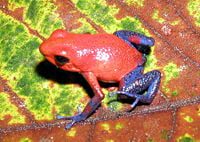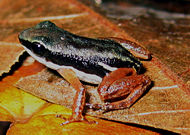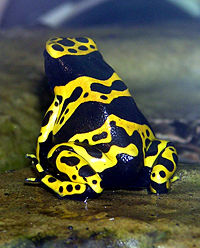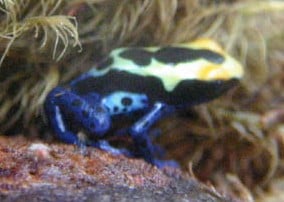Difference between revisions of "Poison dart frog" - New World Encyclopedia
Donald Mull (talk | contribs) |
({{Contracted}}) |
||
| Line 1: | Line 1: | ||
| − | {{ready}} | + | {{ready}}{{Contracted}} |
{{Taxobox | {{Taxobox | ||
Revision as of 15:16, 29 October 2007
| Poison dart frogs | ||||||||||||
|---|---|---|---|---|---|---|---|---|---|---|---|---|
 Red and Blue "Blue Jeans" Dendrobates pumilio Strawberry Poison Dart Frog
| ||||||||||||
| Scientific classification | ||||||||||||
| ||||||||||||
 Distribution of Dendrobatidae (in black)
|
Poison dart frog (also poison arrow frog, dart frog or poison frog) is the common name for many very small, diurnal frogs of the Dendrobatidae family . They are named for their skin that contains poisons that are used by Amerindians to coat their spears or blowgun darts. Although the secretions from all of these frogs is poisonous , only a few species have enough poison to kill a human being (Patocka et al. 1999).
Only a few of these frogs are very brightly colored with red,orange and blue skin pigments. Some have multiple bright colors and some have black stripes or spots in addition to their bright pigments. Some are green with black stripes, others are mottled with black and yellow. Their coloration is very striking and does not blend into the surrounding vegetation. This is often referred to as warning coloration or aposematism. Only the brightly colored members of the Dendrobatidae have toxic skin ( Summers 2003).
Most members of the Dendrobatidae , such as those in the genus Colostethus , are cryptically colored - able to hide or be camouflaged - and do not contain a high level of skin toxins (Summers 2003).
Taxonomy
The family Dendrobatidae consists of 164 species in 11 genera (Frost 2007) :
- Ameerega
- Colostethus
- Epipedobates
- Silverstoneia
- Adelphobates
- Dendrobates
- Minyobates
- Oophaga
- Phyllobates
- Ranitomeya
- Hyloxalus
Distribution
Poison dart frogs live primarily in the neotropical rainforests or cloud forests of Central and South America. Their homes range from as far north as Nicaragua and proceed southward to Costa Rica ,Panama and then as far south as southern Brazil and into Bolivia.
Dendrobates auratus were transported to Oahu ,Hawaii in 1932 by people and continue to thrive there . Some poison dart frogs are also found on the Caribbean island of Tobago (S.N.Z.P. 2007).
The cryptically colored poison dart frogs are usually found on the floor of the rainforest in the leaf litter near pools of water or a stream. Most of the brightly colored members are found in trees or vines. The family name Dendrobattidae and the genus Dendrobates are derived from Greek words : dendro (meaning tree) and bates (meaning walker); thus literally "tree walker" (Schlager 2003).
Toxicology
It is thought that poison dart frogs don't actually manufacture any of the toxic alkaloids they use to defend themselves. Alhough they do not have the ability to produce these toxins, they do have a relationship with alkaloid-rich ants and other insects from which they obtain poisonous alkaloids such as pumiliotoxins or batracotoxins.
In captivity, when the frogs are fed insects such as fruit flies and crickets that do not represent their diet in the wild , and are not rich in the required alkaloids, poison frogs stop producing toxins . In fact, many hobbyists and herpetologists have reported that most dart frogs will not consume any ants in captivity, though ants comprise the larger portion of their diet in the wild. Though all poison frogs lose their toxicity when deprived of certain foods, and captive bred poison frogs (except for one Australian species) are born harmless, a poison frog ,caught in the wild , can retain alkaloids for years. Some poison frogs not only absorb the alkaloids of the ants they consume, but also have the ability to chemically modify these toxins and thus create more toxic variants. For example, while Dendrobates auratus consumes pumiliotoxin 251D and merely stores it, some members of the Dendrobatidae family convert pumiliotoxin 251D to allopumiliotoxin 267A, which is five times more toxic than the original version.
The most toxic of all the poison dart frogs is the Golden Poison Dart Frog (Phyllobates terribilis). It is estimated that one frog harbors enough toxin at any given time to kill between 8 and 20 adult humans.
Because they are vile-tasting (how does anyone know this ? ) and usually deadly when ingested, poison frogs have no natural predators, and this is one factor that adds to their popularity as pets. Since they have no natural predators, the frogs are not bothered at all by the close presence of large animals (how do other animals know they are toxic ??), including humans.
Poison frogs are creatures of great scientific interest to evolutionary biologists. The frog's intriguing ability to resist, store, and manipulate toxins, along with its related role in the food chain, are among the most important discoveries in the study of food-chain evolution. Biologists have speculated that the frogs must have first evolved a resistance to the alkaloids in response to using the ants as a food source. The ability to digest even toxic foods allowed them capitalize on an otherwise-untouched food source, a fairly common event on the evolutionary scale. Once having developed a resistance to such foods over the course of countless generations, any genetic variation that happened to make the ingested poison accumulate closer to the skin's surface would have bestowed a greater advantage with each beneficial mutation. Secreting this new weapon, they would have then evolved their bright colors and adapted to a diurnal schedule in response to the absence of natural predators, and some frogs would go as far as to evolve the ability to manipulate the toxins they consumed, thus increasing their deterrence to predators and their likelihood to survive.
General description

The adults are usually 0.5 to 2.5 inches in length from snout to anus , with most species 0.75 to 1.5 inches (Schlager 2003) or no larger than an adult human thumbnail. One of the largest of these is D. tinctorius,which can reach 2.5 inches (S.N.Z.P. 2007 ).
Reproduction and Parental Care
In most species, eggs are laid near the forest floor by the female, usually in a sheltered and moist spot. In most species of poison frog , the female lays infertile eggs and the male fertilizes them externally in a process called oviparity . Once the eggs are laid and fertilized, one parent (generally the male) guards them until they hatch. The newly hatched tadpoles wriggle onto the back of either the male or female parent, who transports them to water, often a small pool or the water trapped in the axil of a Bromeliad plant. Because female poison frogs are both extremely territorial and competitive, a parent must constantly guard its eggs in order to prevent a rival female from devouring them .
In some species, the female returns to the tadpoles repeatedly to lay infertile eggs for them to feed upon. In a few species this is the only source of food for the tadpoles until they undergo metamorphosis into sub-adult froglets; these species are called 'obligate egg feeders'. Obligate egg-feeding species can be especially difficult to rear in captivity, but many breeders have had success with other food substitutes such as small fish eggs.
Poison frogs in captivity
In captivity, poison dart frogs have a lifespan of 5 to 12+ years, but little data exists for wild frogs. Poison dart frogs are commonly bred in captivity to be non-toxic. Most species reach maturity around 1.5 to 2.5 years of age.
The easiest way to determine the sex of a particular species of poison dart frog is by observation in the wild. Mature male frogs will usually make a mating call after eating or after a heavy misting of water. The sound is similar to that of a series of high-pitched "clicks." In juvenile frogs the sex can sometimes be determined by the profile of the amphibian. The backs of males usually slope down with less of a break than females. Females are usually rounder and show a bigger break.
Another simpler way to sex these frogs is by their toes. A female dendrobate will have narrow toes all the way down and a male's toes get very wide at the ends. Mature males also show a small section of grey skin on their neck.
In captivity, most species thrive where the humidity is kept constant at 80-100% and where the temperature is around 75-80 F degrees (24-27 °C) during the day and no lower than 60-65 F degrees (16-18 °C) at night.
Color morphs
Some species include a number of sub-species 'morphs'. Different morphs represent geographically separated populations of the same species in the wild, showing different coloration. For example, the species Dendrobates tinctorius includes at least a dozen morphs.
ReferencesISBN links support NWE through referral fees
- Frost, D. R. 2007. Amphibian Species of the World: an online reference. Version 5.1 . Electronic Database accessible at [1] American Museum of Natural History, New York, USA. Retrieved September 29, 2007.
- Grant , Taran; Frost, Darrel R.; Caldwell, Janalee P.; Gagliardo, Ron; Haddad, Celio F.B.; Kok, Philippe J.R.; Means, D. Bruce; Noonan, Brice P.; Schargel, Walter E. & Wheeler, Ward (2006): Phylogenetic systematics of dart-poison frogs and their relatives (Amphibia, Athesphatanura, Dendrobatidae). Bulletin of the American Museum of Natural History 299: 1-262. PDF fulltext Retrieved September 29, 2007.
- Dumbacher , J. 2004. New Research Shows that Toxic Birds and Poison-dart Frogs Likely Acquire their Toxins from Beetles :Academy Scientist Dr. Jack Dumbacher Finds Elusive Toxin Source in New Guinea.[2]accessed on 10-20-2007
- Patocka ,J., K. Schwanhaeuser Wulff and M. Marini Palomeque. 1999. Dart Poison Frogs and Their Toxins . The ASA Newsletter,ed. R. Price.ISSN 1057-9419.[3]accessed on 10-20-2007
- Schafer ,R. 1999. Dendrobates auratus.Animal Diversity Web.[4]. accessed on Oct 22,2007
- Schlager,N.(ed.). 2003 . Poison Frogs (Dendrobatidae) .pp. 197 - 210. Amphibians ,Vol. 6. Grzimek's Animal Life Encyclopedia,second edition. Detroit: Thomson Gale publishing .
- S.N.Z.P. (Smithsonian National Zoological Park). 2007.[5]accessed on 10-22-07
- Summers , K. 2003. Convergent Evolution of Bright coloration and toxicity in frogs. Proc. Nat. Acad. Sci. 100 (22): 12533-12534.
OTHER ARTICLE
COLOR PHOTOS OF POISON DART FROGS AND ARTICLE ON TYPES OF POISON PRODUCED [6]
| Chordata - Amphibia - Families of Anura | |
|---|---|
|
Allophrynidae - Amphignathodontidae - Arthroleptidae - Ascaphidae - Bombinatoridae - Brachycephalidae - Bufonidae - Centrolenidae - Dendrobatidae - Discoglossidae - Heleophrynidae - Hemisotidae - Hylidae - Hyperoliidae - Leiopelmatidae - Leptodactylidae - Mantellidae - Megophryidae - Microhylidae - Myobatrachidae - Nasikabatrachidae - Pelobatidae - Pelodytidae - Pipidae - Ranidae - Rhacophoridae - Rhinodermatidae - Rhinophrynidae - Scaphiopodidae - Sooglossidae | |
Credits
New World Encyclopedia writers and editors rewrote and completed the Wikipedia article in accordance with New World Encyclopedia standards. This article abides by terms of the Creative Commons CC-by-sa 3.0 License (CC-by-sa), which may be used and disseminated with proper attribution. Credit is due under the terms of this license that can reference both the New World Encyclopedia contributors and the selfless volunteer contributors of the Wikimedia Foundation. To cite this article click here for a list of acceptable citing formats.The history of earlier contributions by wikipedians is accessible to researchers here:
The history of this article since it was imported to New World Encyclopedia:
Note: Some restrictions may apply to use of individual images which are separately licensed.

